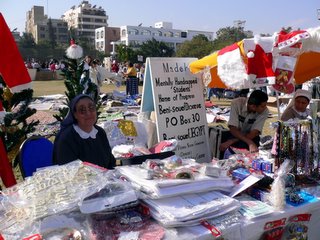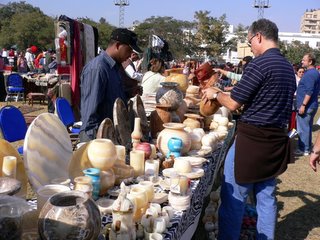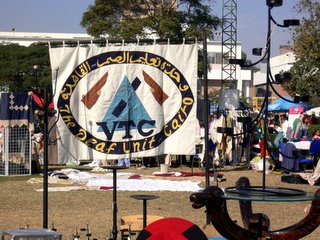 In Canada today would be Boxing Day, the day after the Christmas dinner and gifts, the day that the big sales start. In Abu Sir it's nothing special really, just another beautiful winter day under a clear blue sky after a couple of days of watching the heavy grey clouds of the Mediterranean storms rolling down the valley dropping the occasional load of rain on unsuspecting Cairenes. That's not to say that there is no Christmas celebration here. On the contrary, we celebrate Christmas twice in Egypt, once on the 25th and again January 7th with the Copts and Eastern Orthodox churches. So with two Christmases, the time leading up to the beginning of Christmas on the 25th can be fairly hectic. This year was more so for the people who work at many of the foreign schools that give a Christmas break, because the break usually includes the two holiday dates, bringing students back on January 8th or so. But this year the Greater Bairam, Eid el Adha, starts around the 9th of January, bringing with it an additional week of holiday. So teachers and students were preparing for an extra long Christmas break this year.
In Canada today would be Boxing Day, the day after the Christmas dinner and gifts, the day that the big sales start. In Abu Sir it's nothing special really, just another beautiful winter day under a clear blue sky after a couple of days of watching the heavy grey clouds of the Mediterranean storms rolling down the valley dropping the occasional load of rain on unsuspecting Cairenes. That's not to say that there is no Christmas celebration here. On the contrary, we celebrate Christmas twice in Egypt, once on the 25th and again January 7th with the Copts and Eastern Orthodox churches. So with two Christmases, the time leading up to the beginning of Christmas on the 25th can be fairly hectic. This year was more so for the people who work at many of the foreign schools that give a Christmas break, because the break usually includes the two holiday dates, bringing students back on January 8th or so. But this year the Greater Bairam, Eid el Adha, starts around the 9th of January, bringing with it an additional week of holiday. So teachers and students were preparing for an extra long Christmas break this year.  We don't have the massive Christmas shopping push from stores here, however, and you don't find the stores more crowded at this season than any other. Christmas shopping in Cairo has its own flavour. Part of the season has been a series of Christmas bazaars (or bizarres, as you choose) that are held in various places throughout the city. These support local charities from the income of the bazaar and many shoppers prefer to do Christmas shopping that also helps other people. I have been a patron of the Maadi Women's Guild Bazaar since we moved to Cairo. In fact, when we lived in Alexandria, I knew people who would travel to Cairo to attend it as well. The Maadi Bazaar is held at Cairo American College, the school my children attended, and the students and teachers take an active part in fundraising with games for the children attending the bazaar. The football field is usually covered with tables for vendors, part of them commercial vendors and part of them are charitable organisations who raise funds by selling handcrafts and other items. Here you will find bold printed cotton products with Sudanese drawings printed on them, delicate crocheted table cloths, detailed embroidered hangings depicting village life from Upper Egypt, wooden furniture crafted by mentally handicapped students, applique work and quilting from the recycling center for the Zebeleen in Mokattam, a wide array of items that make lovely presents, especially when taken on a visit back to North America and Europe.
We don't have the massive Christmas shopping push from stores here, however, and you don't find the stores more crowded at this season than any other. Christmas shopping in Cairo has its own flavour. Part of the season has been a series of Christmas bazaars (or bizarres, as you choose) that are held in various places throughout the city. These support local charities from the income of the bazaar and many shoppers prefer to do Christmas shopping that also helps other people. I have been a patron of the Maadi Women's Guild Bazaar since we moved to Cairo. In fact, when we lived in Alexandria, I knew people who would travel to Cairo to attend it as well. The Maadi Bazaar is held at Cairo American College, the school my children attended, and the students and teachers take an active part in fundraising with games for the children attending the bazaar. The football field is usually covered with tables for vendors, part of them commercial vendors and part of them are charitable organisations who raise funds by selling handcrafts and other items. Here you will find bold printed cotton products with Sudanese drawings printed on them, delicate crocheted table cloths, detailed embroidered hangings depicting village life from Upper Egypt, wooden furniture crafted by mentally handicapped students, applique work and quilting from the recycling center for the Zebeleen in Mokattam, a wide array of items that make lovely presents, especially when taken on a visit back to North America and Europe. The commercial vendors are worthwhile as well and part of their income goes to the Guild for the donations to charities. Some of the regulars are the old book salesman who carries wonderful old copies of books, some of them published in the past century, for those who are addicted to things readable, or the amber man who sells silver and amber jewelry...hard to resist. The commercial tables are often a chance for someone with a new product to give it a try with the public. In the past I've found a skilled maker of wooden toys selling ingeniously carved objects sturdy enough for children but smooth and beautiful enough for adult tastes. This year I bought some locally prepared chutney that may find its way into the supermarkets later if the response was good enough.
The commercial vendors are worthwhile as well and part of their income goes to the Guild for the donations to charities. Some of the regulars are the old book salesman who carries wonderful old copies of books, some of them published in the past century, for those who are addicted to things readable, or the amber man who sells silver and amber jewelry...hard to resist. The commercial tables are often a chance for someone with a new product to give it a try with the public. In the past I've found a skilled maker of wooden toys selling ingeniously carved objects sturdy enough for children but smooth and beautiful enough for adult tastes. This year I bought some locally prepared chutney that may find its way into the supermarkets later if the response was good enough. The European Bazaar is another Christmas bazaar held at the Nile Hilton every year, and the participants there are the embassies of the countries of Europe. They bring in shipments of handcrafts, foods, and beverages from the father/mother land and sell these to expatriates who are longing for German knackwurst, Italian panetone and Chianti, Russian nesting dolls, or English sausages. The proceeds from the bazaar again go to charitable organisations to improve or continue their services. The organisers of these bazaars look through the various organisations working in Egypt to find those who are in need of funding and also really performing a necessary service. Significant amounts of funding go to health services for the poor, orphanages, schools for children with special needs, shelters for women and so on.
The European Bazaar is another Christmas bazaar held at the Nile Hilton every year, and the participants there are the embassies of the countries of Europe. They bring in shipments of handcrafts, foods, and beverages from the father/mother land and sell these to expatriates who are longing for German knackwurst, Italian panetone and Chianti, Russian nesting dolls, or English sausages. The proceeds from the bazaar again go to charitable organisations to improve or continue their services. The organisers of these bazaars look through the various organisations working in Egypt to find those who are in need of funding and also really performing a necessary service. Significant amounts of funding go to health services for the poor, orphanages, schools for children with special needs, shelters for women and so on. The other place that I like to do some Christmas shopping is in the smaller shops that I know in Maadi that carry interesting pottery, art and jewelry from local artisans. One of my favourite shops is one called Norag run by a close friend of mine, Mai Greis. Mai has an eye for art that is truly gifted and one can often find wonderful gifts there for almost anyone. She's working on a website for her place and hopefully sometime in the future will be online. She carries pottery from the Fayoum school, wooden and stone carvings made by Bedouin sculptors from the oases, handpainted and sewn Egyptian cotton and linen clothing designed by another friend Marie Claire who divides her time among desert safaris and her artistic endeavours, as well as the odd piece of furniture designed by Mai. Every time I go into Mai's shop I find something new and fascinating.
The other place that I like to do some Christmas shopping is in the smaller shops that I know in Maadi that carry interesting pottery, art and jewelry from local artisans. One of my favourite shops is one called Norag run by a close friend of mine, Mai Greis. Mai has an eye for art that is truly gifted and one can often find wonderful gifts there for almost anyone. She's working on a website for her place and hopefully sometime in the future will be online. She carries pottery from the Fayoum school, wooden and stone carvings made by Bedouin sculptors from the oases, handpainted and sewn Egyptian cotton and linen clothing designed by another friend Marie Claire who divides her time among desert safaris and her artistic endeavours, as well as the odd piece of furniture designed by Mai. Every time I go into Mai's shop I find something new and fascinating. I stopped by a week or so before Christmas because Mai called me to tell me that she was hosting an exhibition of jewelry made by two women we know. Suad Raja has been a friend of mine since the early days in Alexandria when she was a new mother of her daughter Najla and was teaching belly dancing in my living room to a group of other mothers who spent part of the morning working up a good healthy sweat learning to shimmy and twist to the beat of the tabla and the other part of the morning collapsing in hilarious laughter at our own efforts. We are now both much older and less flexible with grown and nearly grown children, but when I see her in my mind's eye I don't see the silver that highlights in her curly black hair (just as it does my own).
I stopped by a week or so before Christmas because Mai called me to tell me that she was hosting an exhibition of jewelry made by two women we know. Suad Raja has been a friend of mine since the early days in Alexandria when she was a new mother of her daughter Najla and was teaching belly dancing in my living room to a group of other mothers who spent part of the morning working up a good healthy sweat learning to shimmy and twist to the beat of the tabla and the other part of the morning collapsing in hilarious laughter at our own efforts. We are now both much older and less flexible with grown and nearly grown children, but when I see her in my mind's eye I don't see the silver that highlights in her curly black hair (just as it does my own).  Suad began designing jewelry based on the traditional Yemeni silver of her youth while Najla was still very young and is the owner of a successful company, Sheba Jewelry, www.shebajewelry.com, based in Cairo but establishing a branch in the US as well. She now commutes between the Washington DC area and Cairo. The other artist, Maie Yanni, worked as a doctor before her children were born, but found that being a mother and a doctor at the same time wasn't very easy, so she decided that it was better to do one thing well than two things not so well. Wanting an outlet for her ideas and creativity, she began making jewelry for herself out of common objects such as fine bone and shell buttons, ribbons, and bits of silver wire. It takes a moment to realise that the lovely necklaces are in fact made from such everyday things as buttons. As friends eagerly bought her pieces, Maie has developed a following which now includes the young friend of mine who received a lovely sea green pendant.
Suad began designing jewelry based on the traditional Yemeni silver of her youth while Najla was still very young and is the owner of a successful company, Sheba Jewelry, www.shebajewelry.com, based in Cairo but establishing a branch in the US as well. She now commutes between the Washington DC area and Cairo. The other artist, Maie Yanni, worked as a doctor before her children were born, but found that being a mother and a doctor at the same time wasn't very easy, so she decided that it was better to do one thing well than two things not so well. Wanting an outlet for her ideas and creativity, she began making jewelry for herself out of common objects such as fine bone and shell buttons, ribbons, and bits of silver wire. It takes a moment to realise that the lovely necklaces are in fact made from such everyday things as buttons. As friends eagerly bought her pieces, Maie has developed a following which now includes the young friend of mine who received a lovely sea green pendant.And what did I get for Christmas? My son decided that it was time his mother had a decent set of mini-speakers for her iPod and computer, so he picked up some on a recent business trip, and my daughter arrived yesterday afternoon with a copy of Temple Grandin's book Animals in Translation. But the best present of all was the time spent in the company of my two children in the home of my friend Jo with two of her children (along with a few other people's now grown offspring) enjoying a traditional English dinner of ham, turkey, Christmas pudding and a lot of laughter. For all of you, I wish the best in the holiday season and the new year. Here is a special image of a winter sunset over the desert to remind you of the joy of the intangibles that we are given, the gifts that mean so much more than anything that can be wrapped.
